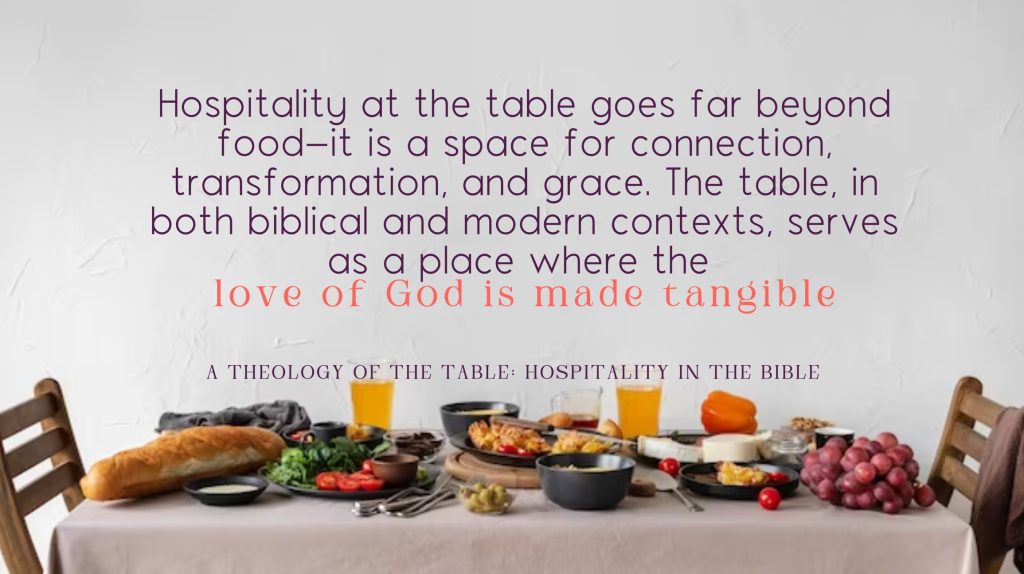When we think about the Bible, we often focus on stories of miracles, battles, or sermons. But a closer look reveals that many of the most significant moments in Scripture happen around a table. From the feasts of the Old Testament to Jesus’ meals with sinners and the promise of the wedding banquet of the Lamb, the table has always been central to God’s plan.
Why is this? What is it about sharing a meal that makes it sacred? Hospitality at the table goes far beyond food—it is a space for connection, transformation, and grace. The table, in both biblical and modern contexts, serves as a place where the love of God is made tangible.
The Table in the Old Testament
Hospitality has always been a marker of God’s people, beginning in the Old Testament. The table was more than a place to eat; it was an opportunity to demonstrate care, respect, and inclusion.
- Abraham and the Three Visitors (Genesis 18:1-8)
In this story, Abraham sees three strangers approaching his tent. Without hesitation, he welcomes them, offers them water, prepares a meal, and provides rest. What Abraham didn’t know at first was that these “strangers” were messengers from God. His willingness to show hospitality became a moment of divine encounter. - The Passover Meal (Exodus 12:1-14)
The Passover was not just a family meal but a defining act of worship. God commanded the Israelites to prepare a lamb and eat it with unleavened bread and bitter herbs. This meal, eaten together as families and as a community, marked their deliverance from slavery in Egypt. The table became a place of remembrance and anticipation of God’s salvation.
In both examples, the table was a space where God’s presence and provision were revealed. It was never just about the food—it was about what the food represented: God’s faithfulness, blessing, and invitation to trust Him.
The Table in Jesus’ Ministry
In the New Testament, Jesus revolutionized the concept of the table. He used meals as a platform for teaching, healing, and building relationships. Over and over, we see Him inviting people to the table—often the very people society rejected.
- Eating with Sinners (Matthew 9:10-13)
When Jesus sat down to eat with tax collectors and sinners, it scandalized the religious leaders. They asked His disciples, “Why does your teacher eat with such scum?” (v. 11, NLT). But Jesus made it clear: His mission was to seek and save the lost. Sharing a meal with the outcasts wasn’t just a gesture of kindness—it was a demonstration of the gospel. - The Feeding of the Five Thousand (Mark 6:30-44)
This miraculous meal shows the abundance of God’s provision. Jesus took five loaves and two fish and fed thousands, not just meeting physical needs but pointing to Himself as the Bread of Life. - The Last Supper (Luke 22:14-20)
The table takes on its most profound meaning here. Jesus used bread and wine to represent His body and blood, instituting a meal that would remind His followers of His sacrifice. The table became a place of covenant, remembrance, and communion with God.
The Table as a Picture of the Gospel
At its core, the table is about connection. It’s a place where strangers can become friends, where burdens can be shared, and where grace can be extended. This is why the table is such a powerful picture of the gospel:
- It’s a place of welcome.
Jesus invites everyone to His table, regardless of status, background, or past mistakes. As Romans 15:7 (NLT) reminds us, “Therefore, accept each other just as Christ has accepted you so that God will be given glory.” - It’s a place of grace.
At the table, no one is better than another. We all come as equals, in need of God’s mercy. - It’s a place of abundance.
The table reminds us that God’s provision is more than enough—not just physically but spiritually.
As we extend invitations to others, we reflect the radical hospitality of Jesus.
The Table in Eternity
The ultimate fulfillment of biblical hospitality is found in eternity. Revelation 19:9 (NLT) describes a day when God’s people will gather for “the wedding feast of the Lamb.” This future banquet is the culmination of God’s redemptive plan—a celebration of His love, mercy, and faithfulness.
Every act of hospitality here on earth points to this eternal feast. When we open our homes and share meals with others, we are giving them a glimpse of God’s kingdom.
Practical Ways to Reflect the Theology of the Table
How can we apply this theology of the table to our everyday lives? Here are a few ideas:
- Be Intentional About Meals
- Make your family table a priority. Turn off distractions and focus on meaningful conversations.
- Invite someone who may feel isolated or overlooked to join you for a meal.
- Simplify Your Approach
- Remember, it’s not about impressing others—it’s about making them feel welcome. Even a simple soup and bread can communicate God’s love.
- Create a Space for Connection
- Use mealtime to deepen relationships, share your faith, or simply listen.
- Celebrate God’s Provision
- Incorporate prayer and thanksgiving into your meals. Acknowledging God as the provider points your heart and the hearts of your guests toward Him.
The Table Is Sacred
The table is more than just a place to eat; it’s a space where heaven meets earth. Every time we extend hospitality—whether through a simple meal or a grand celebration—we are reflecting God’s character and pointing to His eternal banquet.
As you gather around your table this week, ask yourself: How can this meal reflect the love and welcome of Jesus? Who can I invite to experience God’s grace? In doing so, you’ll find that the theology of the table isn’t just something to understand—it’s something to live.





